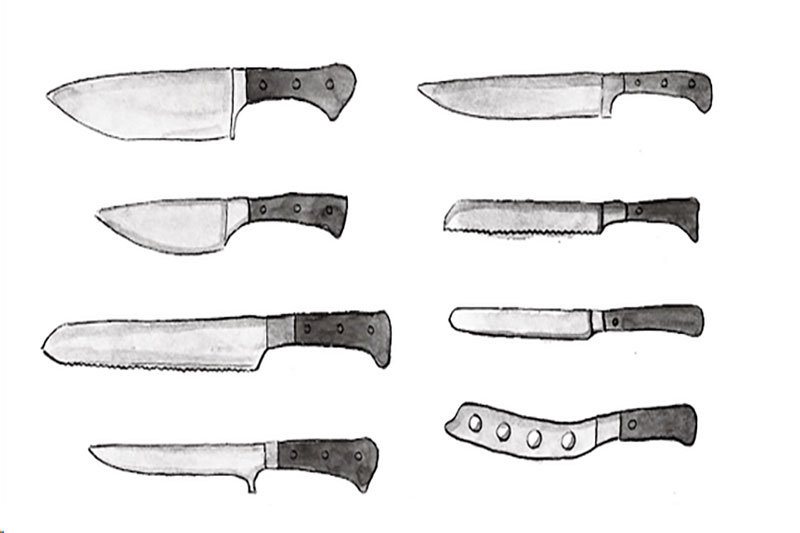Knives are important in food preparation and other daily uses but with the various types of knives, identifying the most suitable one is very a challenge. The variation between different kinds of knives is not as simple as distinguishing them based on appearance or manufacturer but depends on several key factors that determine the performance, sturdiness, and applicability of the knives.
In this comprehensive guide, you will learn all about the most important factors that set knives apart and give you a comprehensive guide to choosing the right knife whether you are a professional cook or just a passionate home cook.

Blade Material
The metal from which a knife’s blade is manufactured goes to the heart of its efficiency and durability. It is important to note that the majority of kitchen knives are made of steel that can be of different grades. It is common depending on its versatility on being rust and corrosion resistant thus suitable for day to day use. However, there are times when stainless steel does not hold an edge as long as high-carbon steel blades.
On the other hand, high carbon steel knives are very sharp and sustainable but have a tendency to rust if not well maintained. Damascus steel, featuring wavy patterns, is made of several layers of steel to improve its density and the ability to hold an edge. Ceramic blades are extremely sharp and are resistant to corrosion but may be relatively fragile. Titanium knives are strong, light weight but are relatively rare and costly.
Blade Shape and Design
Blade shape and design play a crucial role in a knife’s functionality. Chef’s knives, with their broad, curved blades, are designed for a variety of tasks including chopping, slicing, and dicing. Paring knives have a small, pointed blade ideal for intricate work such as peeling and trimming.
Serrated knives, featuring a saw-like edge, are perfect for cutting through tougher materials like bread or tomatoes. Santoku knives, originating from Japan, are versatile with a flat edge and grant a precision cut ideal for slicing and dicing. Each blade shape is crafted to optimize specific cutting tasks, which is why understanding these designs can help in choosing the right knife for your culinary needs.
Blade Size and Thickness
The size and thickness of a knife’s blade directly impact its performance. Smaller knives, such as paring knives, offer precision for delicate tasks but lack the power for heavy-duty cutting. Larger knives, like chef’s knives or cleavers, provide the leverage needed for chopping larger quantities or tougher ingredients. The thickness of the blade also matters; thicker blades are more robust and less likely to bend, making them suitable for heavy-duty tasks, while thinner blades offer precision and are better for fine slicing. Balancing blade size and thickness with your specific needs will ensure efficiency and comfort in your cutting tasks.
Handle Design
The handle of a knife contributes significantly to its ergonomics and overall comfort. Materials for handles range from traditional wood, which offers a classic feel and good grip, to modern plastics and composite materials that are often more durable and easier to clean. Metal handles can provide a sleek appearance but may become slippery when wet. Ergonomics are also crucial; handles designed with contours or textured grips can reduce hand fatigue and enhance control. A well-designed handle will balance the knife properly and make it more comfortable to use, reducing strain during prolonged periods.
Construction and Manufacturing
The method used to construct a knife impacts its quality and performance. Forged knives are made from a single piece of steel that is heated and hammered into shape, resulting in a stronger and more durable blade.
Stamped knives, on the other hand, are cut from a sheet of steel and tend to be lighter and less expensive but may lack the strength and balance of forged knives. Handmade knives often feature meticulous craftsmanship and can be custom-tailored to specific needs, while machine-made knives offer consistency and affordability. Understanding these manufacturing processes can guide you in selecting a knife that aligns with your preferences and budget.
Maintenance and Care
Proper maintenance is essential for extending the life of any knife. Sharpening is a key aspect; knives require regular honing to maintain their edge. Various sharpening tools are available, including whetstones, electric sharpeners, and honing rods, each offering different levels of precision and ease. Cleaning should be done with care; while many knives are dishwasher-safe, hand washing is recommended to preserve the blade’s integrity. Storage also matters; using a knife block or magnetic strip can prevent damage and ensure the blade stays sharp. Adhering to these care practices will help keep your knives in optimal condition.
Cultural and Regional Variations
Cultural knives are specific to a certain type of cooking and have certain features that distinguish them from knives of other cultures. The use of Japanese knives such as the Santoku and Yanagiba indeed captures the spirit of thoroughness of Japanese food preparation. Manufacturers like Wüsthof or Henckels Sakuto Knives offer very robust japanese knives which are suitable for intense cooking techniques. Knowledge of these differences may help you to enhance your culinary practice and learn about different methods and tastes.
Cost and Brand
Pricing of a knife depends on the brand, the type of material used to make it and the quality of workmanship that has been put into it. This is because most brands that are associated with high quality come at steep prices compared to their low-end counterparts. Cheap does not necessarily have to be ugly, provided it is made out of good material and well crafted. Cost and quality also need to be weighed given the frequency of usage of the knife and the amount one willing to spend in overall knife durability.
Conclusion
Selecting the right knife therefore requires a consideration of some factors that define the performance, comfort, and durability of the knife. Everything from the materials that are used to construct the blades and the shapes that they are given, to the handles and even how easy or difficult they are to maintain all contribute to whether or not the knife is going to get the job done and if it is right for the job at hand.
These considerations enable you to choose knives that can fulfill your cooking requirements as well as make the process more appealing and practical. No matter if you are a professional chef, or you just cook for your family, it will be beneficial for you to make the correct choices and thus, you will be satisfied with the outcomes in your kitchen.









